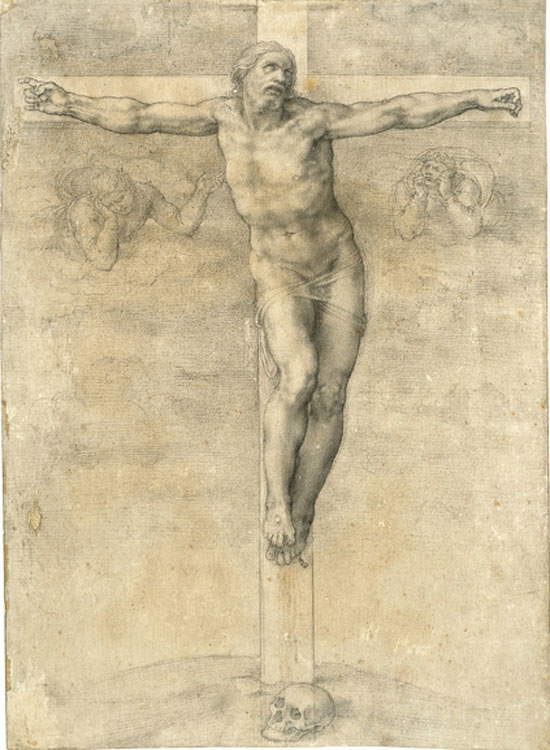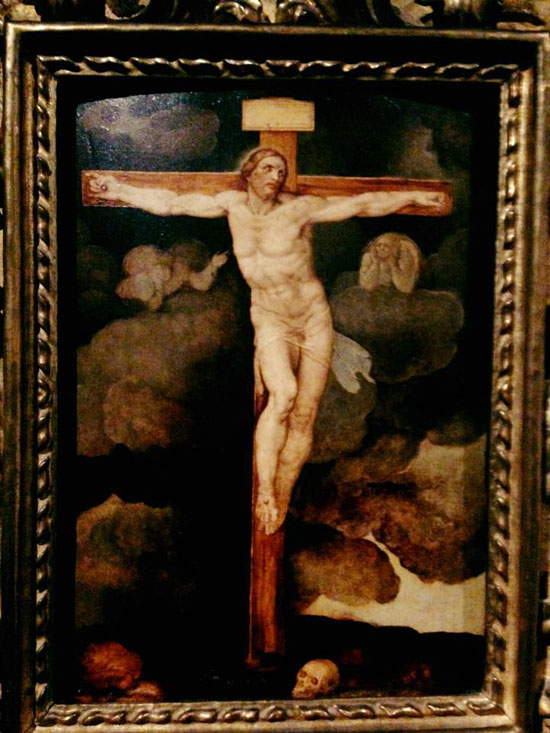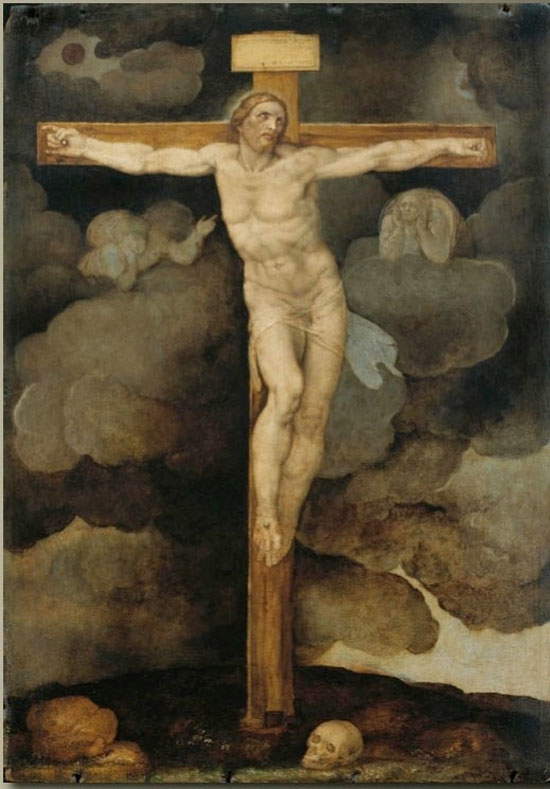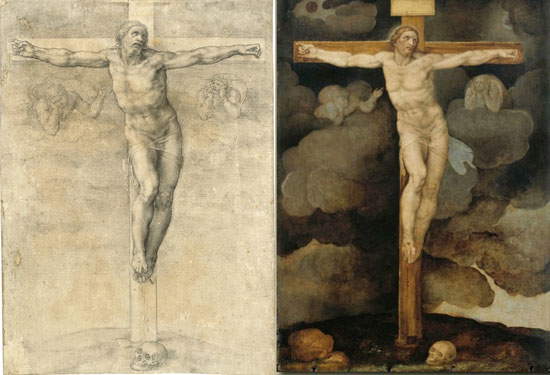Lionello Puppi: Michelangelo's Crucifixion discovered. But we await the opinions of the scientific community
The press office of the El Greco exhibition in Treviso had announced in the last few hours that a new discovery would be presented to the public today: certainly, few imagined that among the others there would be a discovery that, if confirmed, would be of enormous significance. Professor Lionello Puppi has in fact announced that he has found the famous Crucifixion executed by Michelangelo Buonarroti for Vittoria Colonna: a work that until now was thought to be lost and that was known only through a charcoal drawing on paper kept at the British Museum in London, and through copies made by other artists.
Lionello Puppi, a well-known specialist in Venetian art (but who has also worked on Michelangelo), tracked down the painting in a private collection and, as we learn from the Mattino di Padova, considers it stylistically compatible with the British Museum drawing. From the photos so far circulated on the web, not much can be guessed: we publish, below, an image circulated by Art Post Blog, which was present at this morning’s press conference, and a further image proposed by Mattino di Padova. From these first images, the painting (which seems unfinished, however) does not seem to have the same quality as the drawing: the modeling seems coarser, the relief given by the chiaroscuro in the drawing is practically absent in the painting, and the poses of the angels on the sides appear less natural. We repeat, however, that the quality of the diffused images does not allow us to make a proper judgment. Now we will have to wait for the debate, which of course will open, and the opinions of the scientific community to understand whether we are dealing with a real discovery, which if confirmed could really be the most interesting and sensational in recent years, or whether the painting discovered by Lionello Puppi is nothing but a copy. However, the work will remain on display at the El Greco exhibition: so for those who want to see it, the appointment is in Treviso.
Update (6:15 p.m.). We received, just as we were publishing the article, a statement from the press office of the “El Greco in Italy” exhibition containing the reasons that would lead Lionello Puppi to attribute the painting to Michelangelo. We reproduce the text following the images below.
 |
| Michelangelo, Crucifixion for Vittoria Colonna (c. 1538-1541; 36.8 x 26.8 cm; London, British Museum |
 |
| The painting discovered by Lionello Puppi in the image circulated by Art Post Blog |
 |
| The painting discovered by Lionello Puppi in the image disseminated by Mattino di Padova |
 |
| Drawing and painting compared |
The dellinedita pictura thesis of the Crucifixion that sees it attributable to Michelangelo
"Io lho ben visto al lume et col vetro et col specchio et non vidi mai la più finita cosa " (Vittoria Colonna)
The Christ on the Cross panel is a new work in the exhibition placed in the Crucifixion room. Tradition conveys to us an El Greco who did not like Michelangelo Buonarroti, however, it cannot be denied that he took him as a reference and model in his artistic productions, especially regarding precisely liconography of the crucifix. Christ on the cross could be depicted in two manners: either as Christus patiens, thus a suffering Christ, with his head reclined downward, or as Christus vigilans, alive, with an erect head and open eyes or, even, Christus triumphans, with regal attributes, expressing sovereignty over the living and the dead.
Michelangelo Buonarroti is the first to propose a Christus vigilans. El Greco, who initially painted a type of suffering Christ, patiens, only after his landing in Spain followed Michelangelo’s revolutionary liconography, and the Crucifix dated post-1590 and from Auckland Castle can be seen in the exhibition to testify to this.
Regarding the Christ on the Cross, attributable according to Prof. Lionello Puppi to Michelangelo Buonarroti, the cues to support the thesis are:
- There are many clues from the letters exchanged between the artist and Vittoria Colonna: for example, the woman, writes that she has with her Este ambassadors who have asked to see the rough draft of the Crucifix. Michelangelo’s reply has not reached us; we can therefore assume that he sent this rough draft, which corresponds to the work housed in the British Museum (charcoal on paper, 36.8 x 26.8 cm), now visible in a copy in the exhibition for comparison. The finished work has never been received, except in the acknowledgments of the letters and copies by Venusti, of which one can be admired in the itinerary, and others can be found in the Doria Pamphilj and Borghese Galleries in Rome, the Society of Jesus in Oxford and Casa Buonarroti in Florence, to which others were wanted to be added: the variants by Venusti, a pupil of Michelangelo, however, have the addition of the figures of the Virgin and St. John.
- Diagnostic analyses of the work had been done that indicate a stylistic compatibility with Michelangelo, due to the absence of landscape, the presence of storm clouds, and the fineness of the stroke.
- As Professor Puppi suggested in his analysis of the unpublished panel, "it should be noted that the dimensions of the panel are very similar to the preparatory drawing in London.
- Traces of dusting allude to its derivation from a graphic matrix (the rough draft then).
- Reflectography revealed how the placement of the skull, at the base of the cross in the drawing, was originally traced to the right of it as in the painting in the exhibition.
- For the dating of the work, note the presence of a black sun in the panel, which alludes to the April 19, 1539, solar eclipse, not present in Venusti’s achievements.
- Inscriptions are present, visible through photographic examination: from right to left, the cartouche reads in Latin Jesus Nazarenus Rex Judeorum and in translation also in Greek and Aramaic, another feature not found in Venusti
- Finally, in Wood’s light, i.e., the ultraviolet lamp, on the back emerge the marks of an inscription, in ten lines, of which one can only read original his and his own hand’s gift laid out, confirming the thesis that the panel was a gift to the Colonna.
Warning: the translation into English of the original Italian article was created using automatic tools. We undertake to review all articles, but we do not guarantee the total absence of inaccuracies in the translation due to the program. You can find the original by clicking on the ITA button. If you find any mistake,please contact us.



























